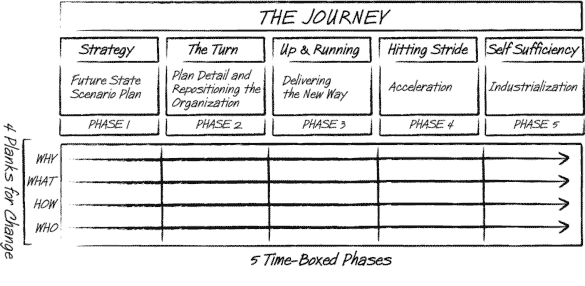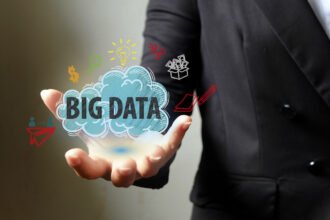Big Data Analytics is now moving beyond the realm of intellectual curiosity to having a tangible impact on business. At this stage of adoption of a new technology, it becomes important to discuss how a Big Data project can move from concept to execution inside an enterprise context. Questions being asked by early adopters of Big Data include: How do I execute a SAP HANA project? How do I execute a GreenPlum data applicance project? How do I extend my legacy application to incorporate Hadoop? How do we implement Oracle Exalytics, Exalogic or Exadata?
- Moving Big Data from Project to Program
- Why do anything around Big Data?
- What needs to change?
- How will we enable the change?
- Who will lead and manage the change?
- The Actual Journey from As-IS -> To-Be
- Change Management and Big Data
- Sources and References
- 1. For details on the change framework and how to actually apply it read Charlie Feld’s book – Blind Spot: A Leader’s Guide To IT-Enabled Business Transformation
Big Data Analytics is now moving beyond the realm of intellectual curiosity to having a tangible impact on business. At this stage of adoption of a new technology, it becomes important to discuss how a Big Data project can move from concept to execution inside an enterprise context. Questions being asked by early adopters of Big Data include: How do I execute a SAP HANA project? How do I execute a GreenPlum data applicance project? How do I extend my legacy application to incorporate Hadoop? How do we implement Oracle Exalytics, Exalogic or Exadata? How do I upgrade my data centers to handle Big Data?
If Big Data Analytics is a program, then the charter is much more complex. Corporations contemplating a Big Data Analytics program should assess their readiness to move forward by creating a strategy/charter/PMO for the overall program. Programs require tenacity, structure and discipline. Successful execution of Big Data will specifically require answers to questions like Why are we implementing Big Data? What challenges are we going to solve first? and Who will lead the implementation?
Moving Big Data from Project to Program
History tells us that large enterprise projects are fragile and require extensive cross-functional cooperation to be executed sucessfully. Unlike processes, which are often aligned with business unit responsibilities, data related projects frequently cross organizational boundaries and do not carry with them a clear line of responsibility. Seemingly small mistakes in upfront data-centric design can generate a cascade of failure in execution.
We believe that enterpises will need a change framework that demystifies technology, serves as a foundation and confidence builder, and is durable across industries, and is simple in nature. A simple framework from Charlie Feld detailed in his new book – Blind Spot: A Leader’s Guide To IT-Enabled Business Transformation – where he succinctly distills the experience gained from running complex IT turnarounds. The firms his team has impacted include Frito-Lay, Burlington Northern Santa Fe, Delta Air Lines, Home Depot, and Southwest Airlines. FedEx, Southwest Airlines and Bank of Montreal.
Charlie Feld’s transformation framework has wide applicability in the execution of Big Data Analytics projects. It applies to startups building products as well as large firms implementing a platform. It essentially consists of the four elements of a compeing change agenda (WHY, WHAT, HOW, WHO) and the five time-boxed phases of the Journey from Current State to the Future Vision.
Why do anything around Big Data?
The WHY change (WHY do anything?). Every journey should begin with a well-articulated “call to arms” or WHY do anything. A clear articulation of WHY, will enable the organization to mobilize, make investments, set priorities, take risks, and sustain the effort. It is the business imperative that must be articulated by the core team, or there is no point in launching a major project costing millions of $$. Crafting the WHY is the responsibility of the core team.
What needs to change?
The WHAT to change (WHAT will we do?). Assuming the WHY change is compelling and can be clearly stated, it becomes critical to describe what actually needs to be done.
According to Feld, it’s important to describe what needs to stay the same. These conversations are going to be difficult and gravitate toward legacy versus new platforms, centralization (BI Center of Excellence model) versus decentralization (a free for all); outsourced versus insourced; or public cloud (AWS) vs. private cloud themes. A more appropriate dialogue should be focused on what Big Data Analytics elements should be common/leveraged and what should be unique. Not doing this right has consequences over time.
How will we enable the change?
This is the pathway from your current to your future state. It is focused on the proper construction and consumption model. This is all about building a blueprint, quality engineering and disciplined program and project management.
The HOW will require readiness assessments, which may be performed internally or using external resources, provide an objective evaluation of the firm’s knowledge, culture, technical environment, data, processes and structure to determine what adjustments (if any) are necessary to maximize the potential for success.
Who will lead and manage the change?
The human aspect is the part of the framework that is required for sustained success. There are four components that differentiate one enterprise from another: Organization, Leadership, Culture and Performance. They all matter whether you outsource, smartsource or go it alone.
The Actual Journey from As-IS -> To-Be
The five distinct phases of the framework are where the project and leadership team implements the organization’s change agenda. Each phase has certain characteristics and outcomes that need to be constantly monitored and managed.
- Phase 1 (Strategy) – In this phase the strategy is articulated by the executive team.
- Phase 2 ( The Turn) – The work in this phase consists of sequencing, pacing and funding the Journey from Current State to Future State.
- Phase 3 (Up and Running) – The deal has been cut, the sequencing has been agreed to and the roadmap has been blueprinted. This phase is about beginning to deliver.
- Phase 4 (Hitting Stride) – This phase is about accelerating quality delivery and agreed to benefits of the change.
- Phase 5 (Self-Sufficiency) – This final phase is about industrialization of the new model and continuous improvement.
Change Management and Big Data
Initiating a Big Data Analytics program represents a change to the way data and information will be provided and used. This requires a holistic approach with effective collaboration between IT and lines of business. Like any other game-changing technologies in the enterprise an understanding of tools is an essential ingredient for implmentation but is not sufficent to making an effective change. Success or failure of a Big Data Analytics program in an enterprise will depend on having a strategy and framework for execution.
Sources and References
1. For details on the change framework and how to actually apply it read Charlie Feld’s book – Blind Spot: A Leader’s Guide To IT-Enabled Business Transformation









